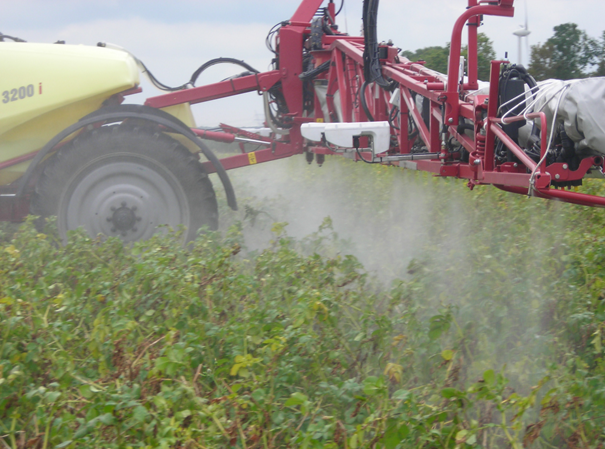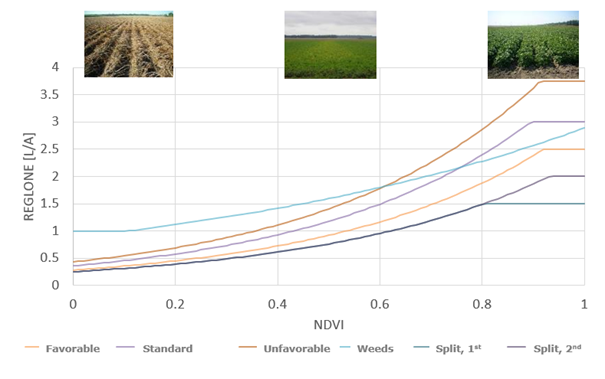
The content of this blog is the World of Potato Research column published in PotatoWorld magazine 2020/03.
Precision agriculture is a farming management concept based on observing, measuring and responding to inter and intra-field variability in crops. In this series I look at precision agriculture applications in potato crops from a Dutch perspective (see Potato Research paper in references). Let us have a look at variable rate application of potato haulm killing herbicides.
For years, the diquat herbicide (Reglone) was the standard in haulm killing in ware and starch potato crops in Europe. And because the minimum effective dose is biomass dependent, variable rate application of Reglone could become the first mature precision agriculture application in Dutch potato production. Savings on herbicide use were between 20 and 50% compared to common practice when dosing was done with biomass maps. Now that the herbicide is not admitted anymore in the EU, farmers will have to adapt their haulm killing practices. We will see more flailing, flaming haulm pulling and even electrocution. But as long as chemicals are still admitted, they will probably be used. The question is: will the alternatives for diquat be applied in a variable rate too?
 Lines showing the relation between site specific crop biomass index (NDVI) and minimum effective Reglone dose for different conditions and systems of potato haulm killing.
Lines showing the relation between site specific crop biomass index (NDVI) and minimum effective Reglone dose for different conditions and systems of potato haulm killing.
The lines shown where derived from field experiments in which we measured light reflection of the potato canopy at specific wavelengths and the dose response of haulm killing herbicides between 1999 and 2005. The mostly used crop biomass index today is NDVI. The higher the NDVI, the more green the crop canopy is. The three pictures are positioned at NDVI classes they represent. The higher the NDVI, the higher the minimum effective dose is. The Standard line (pink) represents average growth conditions in a single treatment. If the farmer decides conditions are favourable or unfavourable, he can take a line which is lower (yellow) or higher (brown) than the Standard . In addition, farmers can choose for split applications or situations to account for residual weeds (light blue). The lines can also be provided for other crop biomass indices, as long as the indices can be based on reflection measurements near the red and near infrared wavelengths of light. Proximal sensors often work with different indices.
Since 2006, we started to integrate the lines / dosing algorithms in variable rate application systems. We first focussed on on-the-go sensing and spaying systems, like Yara N-Sensor in combination with sprayers or the SensiSpray system. The dosing algorithms were integrated in the software that controls site specifically the spray rate. The sprayer shown allows variable rate application per section of the spray boom (2009). Since 2012, crop biomass maps measured with satellite or drone mounted sensors became available. We have integrated the algorithms in software that can covert these maps into make grid based task maps, with medium (ca 10 x 10 m for satellite images) and high (ca. 0.05 x 0.05 m for drone images) resolution. Task maps can e.g. be made with the potato haulm killing herbicide app on the Dutch Akkerweb platform. Both on-the-go and grid based task maps led to significant reduction in diquat use while maintaining good efficacy.
In the same way as for diquat, we developed dosing algorithms for glufosinate-ammonium, carfentrazon-ethyl and pyraflufen-ethyl. The first one is also not admitted anymore since 2020, but the other two can be used in potato haulm killing. Farmers in The Netherlands have indicated that they first want to learn more about the use of the alternatives for diquat before they will start with variable rate applications. The dosing algorithms are available in a webservice of Wageningen University & Research. The algorithms are comparable with the ones for diquat, only slope, minima and maxima are different. The algorithms can be accessed via API by third parties or directly via the potato haulm killing herbicide app on Akkerweb.
Precision agriculture has the promise to produce more with less and better, giving benefit to potato farmers, potato value chains and society. In the case of potato haulm killing, the benefit is not with higher yields, but with more sustainable use of pesticides.
Dr. Ir. Corné Kempenaar (WUR & Aeres)
References
Akkerweb
Advances in Variable Rate Technology Application in Potato in The Netherlands
Want to keep reading about the potato crop, potato production and haulm killing?
Our Potato handbook is a global potato university in 1 book!
Buy your copy today and get a one-year free subscription to PotatoWorld magazine.

